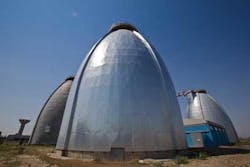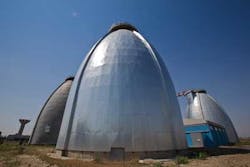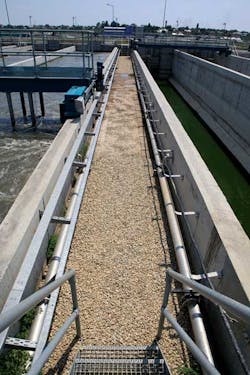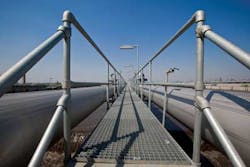Bucharest's Boom: How the City Implemented A Collection System
Bucharest now has a complex wastewater system. This wasn't always the case. A lack of infrastructure has prevented the entire collection and treatment processes from being carried out. Giovana Soara details the privatization journey for Romania's capital city.
Bucharest's first sewers were built in 1828 and from 1900 through to 1950 the main drains with diameters higher than 150 cm were made: six drains on the right riverside and 18 drains on the left riverside of Dâmbovit,a. Wastewater is collected through a system constructed mainly in unitary system (the public sewerage system ensuring the collection, transport, treatment and mutual drainage of both wastewater and stormwater).
The initial design followed a unitary system (wastewater and storm water) based on the lower operation cost criterion and aimed at providing services to a population less than one million inhabitants. The stormwater drainage area was, at that time, as large as 5,000 ha, and soil waterproofing was insignificant.
Since then, operation requirements have changed. The unitary system now has to meet the needs of a population exceeding two million inhabitants and the stormwater draining area is larger than 23,000 ha. Due to the impermeability of the city running surfaces as a result of city development, as well as to the climatic changes resulting in powerful storms, the quantity of water needed to be drained is continuously increasing. As a result, the current state of the wastewater basin was precarious, thus causing problems to the sewerage system and more and more often flooding in certain areas of Bucharest whenever there is heavy rain.
Wastewater Basin
The Dâmbovit,a River crosses the capital from North-West to South-East along an approximately 18 km long artificial riverbed. Its natural course was first detoured in 1985, on a 10 km segment.
Afterwards, from 1985 through 1988, the riverside was reshaped due to a series of significant works, by creating two superimposed water layers arranged as follows:
- At surface – one concrete sewer supplied with water from Lacul Morii (artificial lake)
- Underground – a collecting basin structure, to which all the main drains of the sewerage system are connected
- The basin was designed to drive gravitationally the water collected from the entire city to one treatment plant.
Approximately 18 km long and approximately 45 km in area, the basin operates as a sewerage drain consisting of two semi-basins located on the Ciurel – Opera section; two semi-basins located on the Opera – Vitan section and three semi-basins located on the Vitan – Popes,ti section. The present capacity of the wastewater basin (<50%), built several decades ago, is now insufficient in managing current stormwater.
Until 2011, the basin was managed by the "Romanian Water" National Administration. The Bucharest Municipality was in a situation where it was unable to manage the entire sewerage system of Bucharest. As a result, in 2009 the Bucharest Municipality commenced the formalities to take over the wastewater Basin from the Ministry of Environment.
This ended up in the Government Decision No. 894/2010 regarding the transfer of the wastewater drain beneath the Dâmbovit,a river (wastewater basin) from the State public domain and the management of the "Romanian Water" National Administration to the Bucharest Municipality public domain and the management of the General Council of the Bucharest Municipalities.
Following the execution of the Addendum No. 7 to the Concession Agreement on May 17 2011, the Bucharest Municipality leased the wastewater basin beneath Dâmbovit,a to Apa Nova Bucharest. Ever since 2009, by the execution of the Addendum No. 6 to the Concession Agreement, Apa Nova expressed its consent to integrating the wastewater basin into the sewerage system and in concession, respectively, and undertook to fund a technical survey on the wholeness of the basin amounting to one million Euros.
The survey concluded that the rehabilitation of the wastewater basin requires significant investment but, by such an undertaking, Apa Nova Bucharest will be able to implement a uniform strategy to develop and efficiently manage the wastewater collection and transport system.
As a result, the wastewater basin was leased on May 17th 2011, and Apa Nova Bucharest undertook to maintain and upgrade the basin based on a three-year significant investment plan amounting to 40 million Euros. The upgrade plan involves arrangements to discharge the basin into the Dâmbovit,a river (only under heavy precipitations) and into the wastewater treatment plant, unclogging and elimination of major internal bottlenecks.
The wastewater basin and its related drains have so far been inspected with a view to preparing the survey on cutting down the infiltrations. Its levels and flows have been monitored as part of the infiltration assessment project. Also, sensors have been installed in order to monitor the operation of the basin and the B6 service level. This level regulates the current transit capacity of the wastewater basin at maximum 42.75 m3/s, monitored by the Popes,ti Hydro-technical Knot section. Exceeding such flow amount triggers the operation of the safety down-pipe that directs overflow directly into the Dâmbovit,a River through the safety chamber, in emergency cases.
Glina Wastewater Treatment Plant
The need to develop a complex sewerage system has become clear ever since the '70s - '80s. As a result, mid 80's saw the construction of the wastewater treatment plant begin near the Glina village, to extend the wastewater basin underneath the Dâmbovit,a River.
After 2000, the need for a functional wastewater treatment plant became even clearer. As the cost of the investments with the completion of the Glina Wastewater Treatment Plant was impossible to support by the local population, the Bucharest Municipality decided to directly seek external capital subsidy.
In 2004, the European Commission and the Government of Romania decided to co-fund the project and concluded a Funding Memorandum for the allocation of non-repayable funds for the "Rehabilitation of the Bucharest Wastewater Treatment Plant - Phase 1" (Instrument for Structural re-Adhesion Policies 2004/RO/16/P/PE/003 Project).
Besides the non-repayable ISPA (Pre-Adhesion) funds granted by the European Commission, the funding of Phase 1 was ensured by the loans acquired by the Bucharest City Hall from the European Investment Bank and the European Bank for Reconstruction and Development. This was secured by the Romanian Government as well as funds from the State budget. The entire project was directly managed by the Bucharest Municipality and was completed in June 2011, with the Glina Wastewater Treatment Plant being run by Apa Nova Bucharest.
Achievements and opportunities
Other milestones in the development of Romania's water sector include putting the L3 (line three) connection chamber into operation. Since its construction in 1987 and until present, the wastewater basin has only operated including line two. Although executed, the section from line two to line three was not operational. L3 was repaired, tested and put into operation by Apa Nova Bucharest in 2012, following some complex design and execution works. Line three was extended with an open sewer directly linked to the Dâmbovit,a River which will be provided with the hydro-mechanical equipment needed. The commissioning of such assembly (L3 + open sewer) in spring 2012 significantly increases the discharging capacity of the wastewater basin, namely up to approximately 60 m3/s, in case of especially heavy rains.
Furthermore, the daily monitoring of water collected and transported through the wastewater basin has been improved. The "Operation Regulation" and the "Collaboration Convention" between Apa Nova Bucharest and Apele Române have also been developed.
And future investments are planned. Apa Nova Bucharest plans to complete the provision of the open sewer and the wastewater basin with the hydro-mechanical equipment needed (grids, dams and levees).
A cleaning operation of the wastewater basin is also planned, involving cleaning all access points and connections of the large drains to the wastewater basin and completing the wastewater basin unclogging operation.
Further rehabilitation works are planned for affected areas on the wastewater basin structure in order to restore safety and reduce infiltrations. This will include fitting the equipment with level, flow and quality sensors and fitting the wastewater basin with hydro-mechanical equipment to improve flowing and draining of the water.
Author's note: Giovana Soara is the director of consumer management at Apa Nova Bucharest, the Romanian branch of Veolia Water. For more information, please visit: www.apanovabucuresti.ro/en/.




